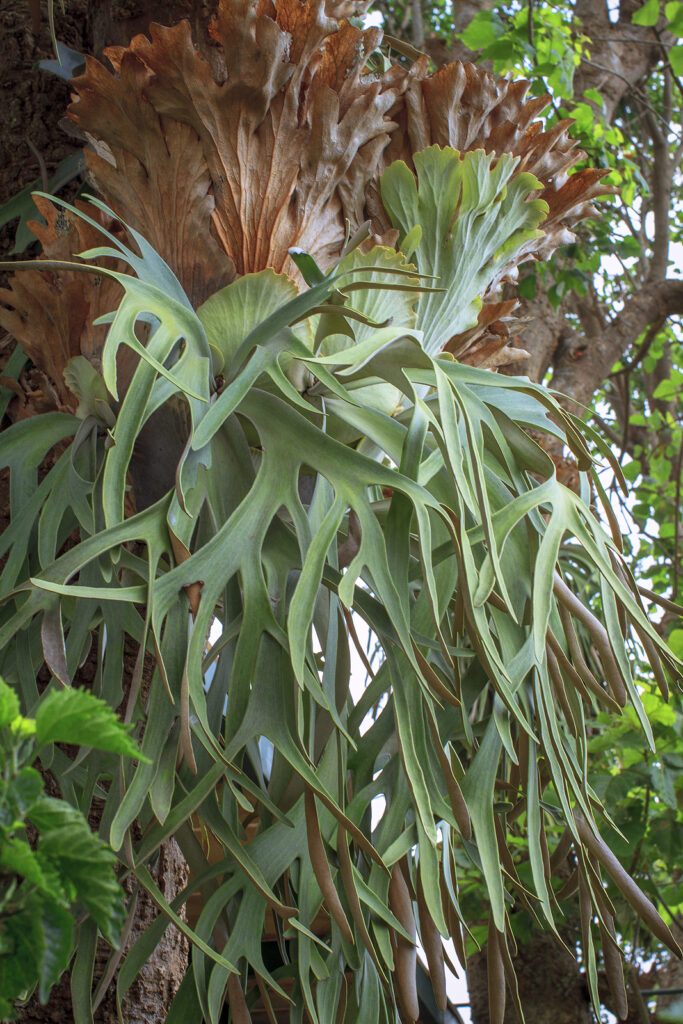Platycerium is an evergreen epiphytic fern that is grown primarily for its elegant foliage. The lobed fronds of Platycerium spread to 36 inches (91cm) high and nearly as wide. They resemble antlers and give the fern its common name–staghorn fern.
Each plant has two types of fronds, sterile and fertile. The single sterile frond is round and flat; it changes from bright green to papery brown before it withers and is replace by new growth. The fertile fronds are grayish green and wedge-shaped; they spread and droop.
Playcerium ferns are usually grown on slabs of bark, on the trunk of a tree, and sometimes in hanging baskets. They are often used as a decorative accents on a patio or porch.
Platycerium are epiphytes; like other epiphytes they sustain themselves on leaf mold and the moisture that gathers around their aerial roots.
Platycerium is a genus of about 15 species of evergreen epiphytic ferns. Platycerium is native to tropical rainforests in Africa, Asia, and Australia.
Get to know Platycerium
- Plant type: Epiphytic fern
- Growing zones and range: Zones 9-11
- Hardiness: Half-hardy; survives 20° to 22°F (-7° to -6°C) with only lath structures for shelter.
- Optimal growing temperature: day, 70° to 75 °F (21° to 24°C); night, 55° to 65°F (13° to 18°C).
- Height and width: To 36 inches (91 cm) long and almost as wide
- Foliage: Stalkless, rounded to oblong fronds can be entire or irregulalry lobed at the upper marins; fronds are spreadin or pendent, wedge-shaped at the bases usually gray green and leathery
- Uses: Grow epiphytically on a tree
- Common name: Staghorn fern, elkhorn fern
- Botanical name: Platycerium
- Family name: Polypodiaceae
- Origin: Tropical rainforests in Africa, Asia, and Australia

Where to plant Platycerium
- Light indoors: Bright light, with no direct sun, from eastern or western exposure. Does well under artificial light, needing 14 to 16 light-hours daily.
- Soil outdoors: Grow on tree bark, hanging in a tree.
- Soil: Anchor to bark or tree fern with a pad of long fiber sphagnum moss behind the frond, or set in hanging wooden basket filled with equal parts peat moss and sphagnum moss.
When to plant Platycerium
- Set Platycerium outdoors in spring.
Planting and spacing Platycerium
- Space Platycerium 36 inches (91 cm) apart.
How to water and feed Platycerium
- Water: Let Platycerium dry almost completely between thorough waterings. If a frond covers the surface of growing medium, submerge plant in water. Mist Platycerium twice daily. Platycerium prefers humidty of 50% to 80%.
- Feeding: Fertilize mature Platycerium every 3 weeks during growing season, with mild liquid fertilizer.
Platycerium care
- Platycerium rests during fall and winter. Keep Platycerium at 55° to 65°F (13° to 18°C). reduce water, keeping barely moist; withhold fertilizer.
Platycerium pests and diseases
- Check Platycerium for aphids, fungus gnats, mealybugs, scale insectrs, slugs, and snails.
Platycerium propagation
- Propagate Platycerium by detaching plantlets at the base of the plant that are at least 4 inches (10 cm) wide, or spores.
Platycerium varieties to grow
- Platycerium bifurcatum, staghorm fern. Epiphytic fern with erect or horizontal, rounded to heart- or kidney-shaped sterile fronds that are pale green when young, later tan or brown, and gray-green fertile fronds that are erect, spreading or pendent and forked 2 or 3 ties into strap-shaped segments; grows 36 inches tall and 32 inches wide; the fertile fronds appear in forked configurations resembling deer antlers, inspiring the fern’s common name; a popular plant from which many cultivars have been derived.



